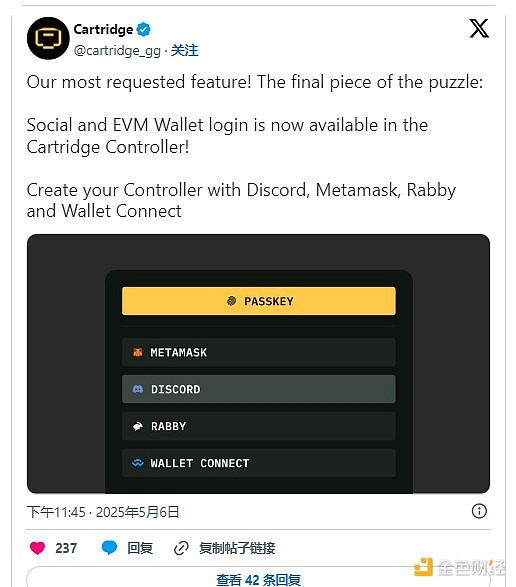Source: William M. Peaster, Bankless; Translated by Tao Zhu, Golden Finance
Fully on-chain games store all their logic (including assets, rules, and state) on the blockchain or Rollup.
Compared to mainstream games that run on private, isolated servers and give players little sovereignty, the decentralized approach of on-chain games provides players with asset ownership, an open economic system, open modding, persistence, and transparency.
Despite the fact that this design space is only a few years old, on-chain games currently lag behind mainstream games in terms of smooth user experience (i.e. ease of use) and speed (i.e. low latency).
The good news is that the ecosystem is getting better on both counts.
Account abstraction innovation is currently effective in solving user experience problems. For example, the first season of Eternum gameplay started today, and my cartridge controller allowed me to generate an Eternum wallet and start a session key simply by logging into my Discord account.

But what I see at the moment is another wave that will be of great benefit to fully on-chain games, and that is the trend of infrastructure towards speed (ie low latency block time).
If you're not familiar, latency is the time delay between a player's action and the in-game result of that action. In mainstream online gaming, latency is the time it takes for data to travel from a player's device to the game server and back.
In on-chain games, the same principle applies, but the server is replaced by a network or Rollup that executes game logic and updates state.
In general, the ideal latency for online gaming is between 30 and 60 milliseconds (ms), as this speed provides a smooth and responsive experience for most players; latency over 300 ms can feel sluggish.
Compare this to Ethereum Layer1, where the average block time is currently 12 seconds or 12,000 milliseconds. Of course, you can still build on-chain games on Ethereum, but its high latency makes real-time competitive gaming difficult to achieve.
However, other places are much faster, and in some cases, even faster.
For example, Base. Its current block time is 2 seconds, but this will drop to 200 milliseconds once Flashblocks lands on its mainnet in the coming weeks. This upgrade will pave the way for faster gaming on Layer 2, and more games may be added in the future.

Of course, another L2 that must be mentioned is MegaETH. Currently only its testnet is online, but it has a unique mini-block design that allows blocks to be produced every 10 milliseconds.
In the esports space, block times of 20ms or less are considered excellent, so MegaETH has huge potential to support a thriving competitive gaming scene. If you want to get an early taste of how fast it will work, you can play a live Crossy Fluffle game on the L2 testnet today.
As for other L1s, Solana also has great potential in this area. The network has a block propagation system using “shards” which allows for latency of around 15ms, making it ideal for gaming use cases.
Another interesting highlight is community solutions such as the MagicBlock on-chain game engine. It provides a custom ephemeral rollup architecture that helps Solana applications achieve block times of around 10 milliseconds. One game built on this stack is Supersize, a multiplayer memecoin eating game.

Therefore, with the launch of new fast blockchains like MegaETH, and existing networks continuing to increase in speed through innovative technologies such as Shreds and Flashbocks, we are entering a whole new realm where fully on-chain games will finally be able to achieve the low latency levels that mainstream game private servers can provide.
This trend paves the way for new types of advanced on-chain games with real-time gameplay, and the broader prospect is that a world of competitive, player-controlled on-chain esports is now within reach.
Of course, pursuing lower latency does not guarantee game quality, but it does remove one of the last few technical barriers preventing us from developing the on-chain games that many people love and look forward to. Therefore, new groundbreaking games are coming.
 Weatherly
Weatherly






